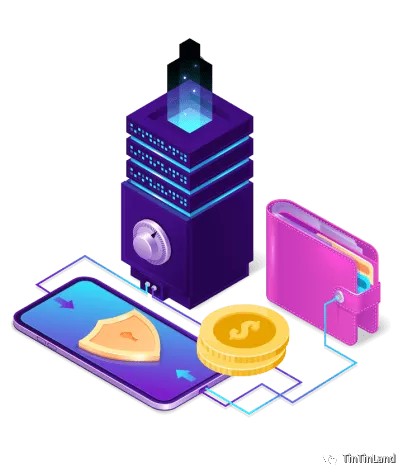The recent popularity of RWA has attracted the attention of those interested in on-chain financial transactions.RWA, as a typical example of mapping assets in the traditional market through virtual digital assets, has opened up a new path for the traditional financial industry to improve quality and efficiency in a bear market. In fact, RWA is originated from the demand for democratization and equalization of the financial industry, and can also bridge the gap between off-chain and on-chain asset transactions. While RWA is spreading application construction in full swing in various places, we also need to pay attention to various security audit issues and solve the real challenges of insufficient technical awareness.
The 21st issue of TinTinWeekly invited Solv Protocol co-founder Meng Yan, Blockchain@UBC core member Wang Zehua, UWEB (University of Web 3) principal Yu Jianing, and audience friends concerned about Web 3 digital asset storage and management to gather in the live broadcast room.Let’s explore together how RWA builds the future of real-world assets through decentralized finance.
wonderful point of view
The explosion of RWA is inseparable from the development needs of the traditional financial industry, and is the result of the two-way rush between traditional finance and Web 3
RWA promotes the equalization and democratization of the virtual asset world, and responds to the publics desire for open and safe asset transactions
Solving industry regulatory problems and eliminating asymmetry in capabilities and resources can ultimately achieve RWA development goals
The seamless connection between on-chain and off-chain assets has become an important part of controlling RWA security risks
RWA brings real-world assets into Web 3 and drives traditional financial transaction interaction
Originating from the demands of the financial industry, it has the potential to boost assets
The sudden explosion of RWA is a very interesting thing. This explosion comes from the needs of both markets. If Crypto hopes to obtain more stable and safer returns in a bear market, it will seek asset forms such as RWA. And behind this,It is the people working in the traditional financial field that promote the rise of the RWA trend, in the traditional financial world, everyone discusses more real-world assets covering various directions, including all bonds, debts, accounts, etc. into Web 3 issues. It can be seen that it is precisely because RWA has the potential to stimulate the development of the traditional financial world that it has been placed with high hopes for development by stars holding the moon.
In November last year, an important report released by BCG stated that RWA and tokenization will bring a market of US$16 trillion in 2030. “The development goal of RWA is to build the next generation of global financial infrastructure. It believes that all assets in the world should be tokenized, and all tokenized assets should be put on a central bank chain. Such development goals can promote Invigorate traditional financial transactions and improve the speed and circulation of asset transactions, Teacher Meng Yan summarized.
Guarantee the property rights and interests of assets and meet the expectations of the public
The sudden explosion of RWA is the result of the two-way rush between traditional finance and Web 3. Traditional assets have liquidity and international needs, which leads them to seek the idea of uplinking. Mr. Wang Zehua pointed out that the explosion of RWA is mainly to ensure The rights and interests attribute of asset management. When we think about the equity attributes of assets,One is the interest; the other is the right. In the traditional world, what we think about is whether these assets can be turned into on-chain certificates, and then put into operation in the international market. RWA is the choice to solve such a practical need. Perhaps in the next 2-3 years, a large number of RWA-related infrastructure, regulatory laws, development technologies, and real RWA assets will arrive.

In the past, the traditional financial industry was lying to make money in the so-called low interest rate environment, and it really didn’t need the thinking of improving quality and efficiency, but now the shadow of the bear market has not dissipated, and the public has been looking forward to the advent of new tools that can drive the development of the financial industry. In fact,RWA is such a technology choice that can promote the equalization and democratization of the virtual asset world, and satisfy the publics desire for transparent, open, smooth and safe asset transactions.If RWA allows more assets to circulate on the blockchain in the future, then the inclusive goal of people all over the world participating in the financial industry is expected to be realized.
The prospect of RWA development is bright and bright, but the road is dangerous and dangerous
There are two sides to the story. Corresponding to the explosion of RWA is the prominent development problem and dilemma behind it. As Mr. Meng Yan said, The distant prospect of RWA development is bright, but there are various hidden reefs and dangerous shoals nearby.
Gather industry consensus to overcome regulatory challenges
The biggest challenge facing RWA at present is undoubtedly regulation. Traditional financial institutions are very enthusiastic and actively building a consensus on RWA, but regulators in various countries are very procrastinating. There is a large gap between the lagging and unhurried response of the regulatory agencies and the enthusiasm of the financial circle for breakthroughs and innovations.This is a big challenge for the development of the industry. Like the problem of asset docking under the chain, ensuring the security and transparency of platform funds is ultimately a regulatory issue.
In addition, many regions are still facing the asymmetry of capabilities and resources. Those who master RWA real-world assets do not master technology, and do not even understand the concepts formed by blockchain over the past decade; those who master knowledge and software technology do not have financial assets in the traditional world. If this asymmetry between assets and capabilities is difficult to bridge, it will also hinder RWA from realizing higher-level asset on-chain. From this we can see that only by forming a large-scale RWA development consensus and reaching a tacit understanding among the government, users, and financial professionals can more funds and technical resources be gathered to speed up the process of asset on-chain.
Pay attention to security risks and give early warning of technical problems
It is precisely because of the omissions in the response and layout of the current regulatory agencies that technicians and the general public need to face the hidden application risks of RWA. For example, the process of docking assets on the chain and assets off the chain, the docking part includes the verification of smart contracts and the audit of project assets, but currently the technical operations of these processes are not fully displayed in a transparent manner throughout the process. Especially the fledgling RWA project,When to conduct a security audit depends on the size of the service scope. Is the price of off-chain assets seamlessly and timely connected to the chain?This is an important part of controlling RWA security risks. This kind of security audit should have a global vision and plan a sophisticated security review system.

In this regard, Mr. Wang Zehua proposed two technical directions that urgently need attention and solutions: on the one hand, strengthen the prevention and attack of hackers, and increase the cost of hackers; on the other hand, improve the security of the approval system and technology, and repair in advance Visible loopholes.
Encourage developing countries to build RWA and build a bridge of cooperation
In Southeast Asia, the Middle East, Asia and other regions, there is a strong desire for RWA to build a new generation of financial systems.This eager desire for development is an opportunity for RWA, but behind the desire is a digital divide that still needs to be bridged(Digital divide refers to the trend of polarization in the level of information cognition caused by differences in information and network technology possession, application level and innovation ability among different countries and regions in the process of global digitalization).
The African region has a very different attitude towards RWA and the central bank, digital currency, and the use of blockchain to construct the next-generation financial infrastructure from developed countries and China.Although the African region does not have a beautiful currency system and financial management system, nor does it have a very developed mobile Internet and mobile payment system like China, but they are keen to find opportunities to build RWA, said Meng Yan based on personal experience.
African people are very eager to use RWA to build a new generation of financial systems, but local financial technology experts and entrepreneurs have very low levels of understanding and awareness of blockchain. They dont understand the main blockchain technology and advantages, nor do they understand the specific principles and steps of on-chain asset transactions. There is enthusiasm for action, but it is difficult to have scientific thinking. Such an investment will most likely fail. The guest teachers in the live broadcast room said.
In fact, not only in Africa, Southeast Asia and other places, but also in various non-developed regions of the world, there are more or less technical cognition difficulties. The first solution is to spread technology propaganda on a large scale, whether it is news reports, courses, etc. Activities or offline project product roadshows can help them establish a basic understanding of this industry. at the same time,If people in the industry, government departments, and investment experts can establish a good cooperative relationship and use the resource strength of the government and the financial strength of investors to further popularize the RWA technology dividend, then I believe that its vigorous development is not far ahead.










